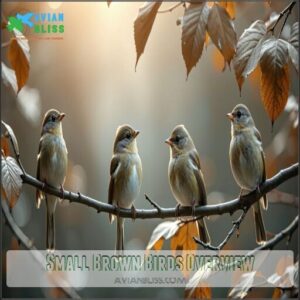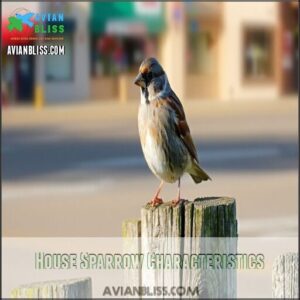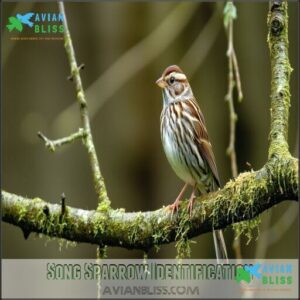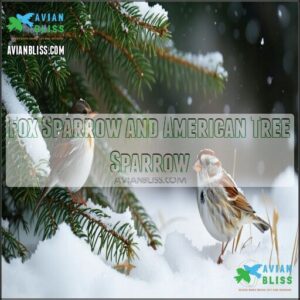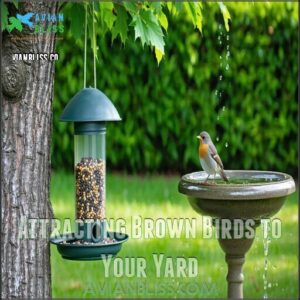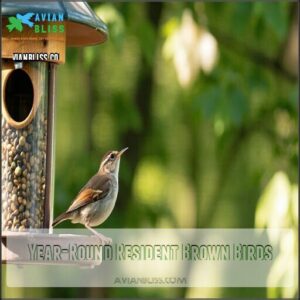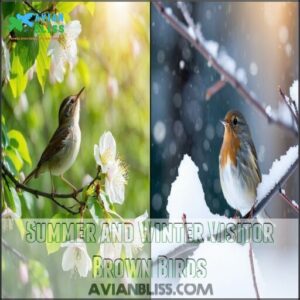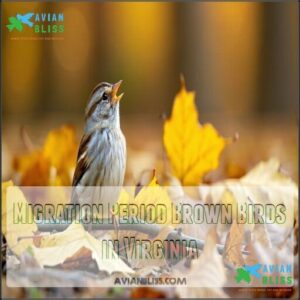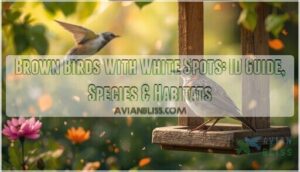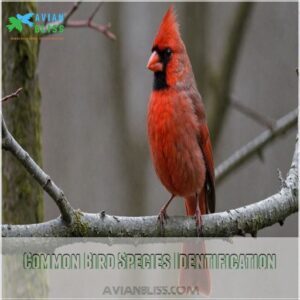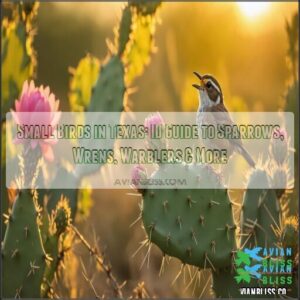This site is supported by our readers. We may earn a commission, at no cost to you, if you purchase through links.
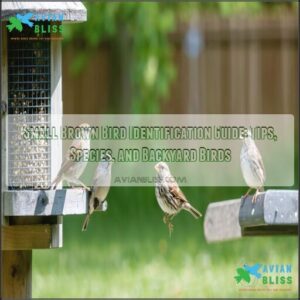 Your "small brown bird identification guide" starts by focusing on details like size, beak shape, and behavior.
Your "small brown bird identification guide" starts by focusing on details like size, beak shape, and behavior.
Look for House Sparrows with their stout beaks and grayish heads, or Song Sparrows sporting streaky feathers and a melodic trill.
Female House Finches are plain but often found with their colorful male counterparts, while White-throated Sparrows flash distinct white throat patches.
Don’t overlook surprises like female Red-winged Blackbirds, often blending in near water, and pay attention to feeding habits and movement patterns—are they hopping on the ground or fluttering at feeders?
Sometimes, the smallest clues reveal big discoveries, and being ready for more can lead to exciting findings, so Let’s explore!
Table Of Contents
- Key Takeaways
- Small Brown Birds Overview
- Brown Bird Identification Tips
- Sparrow Species Identification
- Attracting Brown Birds to Your Yard
- Brown Bird Species in Virginia
- Frequently Asked Questions (FAQs)
- What are some common small brown birds?
- How do you identify small brown birds?
- Are brown birds hard to identify?
- What is a small brown bird at a feeder?
- How do you know if a sparrow is a brown bird?
- Where do small brown birds live?
- What is a little brown hedge sparrow like bird?
- What small bird looks like a brown thrasher?
- What is a small brown finch called?
- What is the lifespan of small brown birds?
- Conclusion
Key Takeaways
- Focus on size, beak shape, and plumage patterns to identify small brown birds quickly and accurately.
- Pay attention to behaviors like hopping, foraging styles, and vocalizations for additional identification clues.
- Create bird-friendly spaces with feeders, water sources, and native plants to attract small brown birds to your yard.
- Learn key differences among common species like Song Sparrows, House Sparrows, and Fox Sparrows by observing their unique markings and habitats.
Small Brown Birds Overview
You’ve probably noticed small brown birds flitting through your yard, but telling them apart can feel tricky.
These birds share similar colors, yet their unique sizes, shapes, and behaviors help you identify them with ease.
Common Small Brown Bird Species
Some of the most common small brown bird species include House Sparrows, Song Sparrows, and House Wrens.
Their bird size and plumage variation make them easy to spot if you know what to look for.
With diverse habitat preferences and feeding habits, they thrive in backyards, parks, and fields.
Regional differences affect sightings, adding excitement to brown bird identification, which is influenced by regional differences!
Characteristics of Small Brown Birds
Spotting small brown birds takes practice! They may look alike, but unique details set them apart.
- Plumage Variations: Subtle shades of brown, streaks, and patches differ, especially among subspecies.
- Juvenile Markings: Young birds often sport fluffier, duller feathers.
- Molting Patterns: Feathers change seasonally, making brown bird identification a fun challenge.
Keep an eye on these traits when observing small bird species!
Habitats and Distribution of Small Brown Birds
Small brown birds thrive in diverse spaces like urban bird habitats, wetland bird habitats, fields, wooded areas, and suburbs.
Each species has its favorite spot—Song Sparrows love marshy bushes, House Sparrows flock to towns, while Fox Sparrows prefer dense tangles.
Exploring bird habitats reveals how adaptable these birds are, making bird species identification as much about location as appearance.
Brown Bird Identification Tips
You can identify small brown birds by focusing on their size, shape, and unique details like color patterns or beak shape.
Spotting small brown birds gets easier when you focus on their size, shape, plumage details, and delightful behaviors.
Pay attention to their behavior and vocalizations, as these can offer helpful clues too.
Size and Shape Identification
Bird size and shape are your starting points for small brown bird identification. Think of their proportions like a puzzle.
- Compare relative size, like sparrow versus finch.
- Check tail length—short and stubby or long and elegant?
- Note bill size and shape—thin for seeds, stout for insects.
Knowing a bird’s size helps narrow down the possibilities. This bird identification guide simplifies spotting your feathered friends and provides a way to understand bird size and identification.
Color Pattern and Behavior
Bird identification by color and behavior can be fun.
Plumage variations help you spot differences; some birds blend into tree bark, while others show bright streaks or spots.
Social interactions like tail flicks or breeding displays reveal clues too.
Here’s a quick guide:
| Feature | Example Style | Purpose |
|---|---|---|
| Plumage Variations | Streaked or Spotted | Camouflage, Identification |
| Social Interactions | Tail Flicks, Calls | Communication, Territory |
| Foraging Styles | Ground, Suet Feeders | Food Preferences |
Reorganizing the paragraph structure improves readability by logically grouping complete concepts into separate lines, with double new lines to visually separate each group.
Beak Shape and Vocalizations
A bird’s beak isn’t just for show—it’s part of their identity.
Pay attention to these clues:
- Beak Morphology: Thin, pointed bills hint at insect-eaters. Chunky, conical shapes show seed specialists.
- Song Complexity: Melodic birds often have intricate songs.
- Call Variations: Chirps, trills, and buzzes differ by species.
- Mimicry Abilities: Some birds copy calls—impressive, right?
Your bird identification guide just got easier!
Sparrow Species Identification
You can spot different sparrow species by paying attention to their size, markings, and habits.
From the urban House Sparrow to the melodious Song Sparrow, each has unique traits that make identification easier.
House Sparrow Characteristics
The House Sparrow, an introduced species, thrives in urban areas thanks to its remarkable adaptation.
This small brown bird has a round body, grayish crown, and streaked back.
Its physical traits make it easy to spot in parks or near strip malls.
With strong social behavior, it builds nests in crevices or eaves, showcasing fascinating nesting habits for bird enthusiasts.
Song Sparrow Identification
If you’ve spotted a small brown bird with streaked plumage variations perched low in damp habitats, you’ve likely met a Song Sparrow.
These sparrows show regional subspecies, each with unique looks. Juvenile markings often include softer streaks.
Listen for their vocalization nuances—clear, melodic whistles. A reliable bird identification guide helps master their charm amid habitat variations, and understand their overall vocalization nuances.
Fox Sparrow and American Tree Sparrow
Fox Sparrows and American Tree Sparrows are small brown birds known for their unique traits.
Fox Sparrows favor dense thickets, while Tree Sparrows prefer open, grassy habitats. Fox Sparrows are larger, with reddish streaks, while Tree Sparrows display a central breast spot.
Migration patterns differ; Fox Sparrows thrive in southern winters, as Tree Sparrows forage across northern regions.
American Tree Sparrows exhibit adaptations for cold climates. Perfect for any bird identification guide, they showcase unique traits and cold climates adaptations.
Attracting Brown Birds to Your Yard
If you want to attract small brown birds to your yard, focus on creating a space that meets their basic needs.
Design a cozy yard with feeders, water, and shrubs to invite lively brown birds for endless backyard enjoyment.
Set up feeders with seeds they enjoy, add a water source, and provide plenty of shrubs or trees for shelter and nesting.
This approach will help create a welcoming environment for the birds, emphasizing the importance of a well-designed yard with shelter.
Providing Varied Bird Feeders
Want to see more backyard birds at your feeders? Offer a variety of seeds like millet, sunflower, and nyjer in different feeder styles.
Hang feeders at safe, visible spots, and clean them often to avoid spreading disease. Consider squirrel-proofing to protect your birdseed.
Native plants offer shelter and nesting sites.
Adjust feeder placement with seasonal changes—it’s all part of the fun of your bird watching guide to attract more birds with the right variety of seeds.
Offering Water Features and Nest Boxes
Adding a small water source like a fountain or birdbath attracts small brown birds.
Place it near shrubs for safety. Clean water features weekly to prevent algae.
Consider adding a bird bath fountain for added visual appeal.
Install sturdy nest boxes made from untreated wood. Position them away from feeders to reduce disturbances. Use predator guards to protect eggs.
These steps make your yard inviting for birdwatching and identification.
Creating Bird-Friendly Habitats
Transform your yard into a haven for backyard birds by planting native plants, which provide natural food and shelter.
Include water sources like birdbaths for hydration. Offer shelter options such as shrubs or nesting boxes to protect them from predators.
Practice sustainable habits, like avoiding pesticides and keeping bird feeders stocked with birdseed. Consider adding various styles available to attract more birds.
Small adjustments bring birds closer, and by following these steps, you can create a welcoming environment that supports the well-being of backyard birds.
Brown Bird Species in Virginia
You’ll find a surprising variety of small brown birds in Virginia, each with unique traits and habits.
From year-round residents to seasonal visitors, these species bring diversity to forests, fields, and suburban backyards.
Year-Round Resident Brown Birds
Your yard is home to year-round brown birds like the House Sparrow, Mourning Dove, and Carolina Wren. These common brown birds love urban areas and blend into Virginia’s bird diversity.
Resident bird habitats vary, but these backyard birds often visit feeders. Identifying resident birds is fun when you notice their unique bird feeding habits—plus, it’s an easy way to support resident bird conservation.
Some birds, like the Peregrine Falcon’s recovery, demonstrate successful conservation efforts in the state, showing the impact of bird diversity on local ecosystems.
Summer and Winter Visitor Brown Birds
While some brown birds stick around all year, you’ll notice unique seasonal visitors too.
Summer visitors like the House Wren and Brown Thrasher brighten your backyard with lively songs.
In winter, species such as the Fox Sparrow and White-throated Sparrow appear, drawn to feeders and brushy areas.
Understanding habitat preferences helps in identifying birds during these seasonal shifts.
Migration Period Brown Birds in Virginia
During migration in Virginia, small brown birds like the American Tree Sparrow and Rusty Blackbird rely on stopover habitats to refuel.
Migration triggers, such as weather and daylight changes, guide them between breeding grounds and wintering areas.
Understanding flight patterns helps refine your bird identification skills, and protecting these habitats is key to their conservation status and ensuring their journeys remain smooth.
Frequently Asked Questions (FAQs)
What are some common small brown birds?
Think of a feathered treasure hunt.
Common small brown birds include the House Sparrow, Song Sparrow, Fox Sparrow, Chipping Sparrow, and Golden-crowned Sparrow.
Each brings unique songs, habits, and charm to your birdwatching adventures.
How do you identify small brown birds?
Start with the bird’s size and shape.
Look at the beak—pointed, stout, or thin.
Notice patterns like streaks, spots, or solid colors.
Behavior and habitat clues, like ground feeding or shrub hopping, help too, and are key to understanding the bird’s overall characteristics.
Are brown birds hard to identify?
Isn’t it tricky when so many birds look alike?
Small brown birds can be challenging to identify because they often share similar colors and patterns.
Focus on habitat, behavior, and unique markings for clues!
What is a small brown bird at a feeder?
A small brown bird at a feeder could be a House Sparrow, Song Sparrow, or even a Chipping Sparrow.
Look for size, markings, or feeding behavior—like ground-hopping or millet-loving—to narrow down your ID.
How do you know if a sparrow is a brown bird?
You’ll know if a sparrow is a brown bird by its earthy tones, often mixed with gray or buff.
Look for streaks or spots on feathers, a stubby beak, and lively ground-feeding behavior.
Where do small brown birds live?
Home is where the habitat is!
Small brown birds thrive in places like forests, wetlands, suburban yards, and open fields.
They adapt well, finding cozy nooks in bushes, trees, and even bustling urban areas.
What is a little brown hedge sparrow like bird?
It sounds like you’re describing a Dunnock, also known as a hedge sparrow.
They’re shy, enjoy hopping along hedges, and have a streaky brown body with a grayish chest.
You’ll spot them flitting quietly nearby!
What small bird looks like a brown thrasher?
Imagine a bird with rich, reddish-brown plumage and bold streaks lining its belly—similar to a brown thrasher, but smaller.
The Song Sparrow fits this description, often spotted hopping among shrubs or singing vibrantly.
What is a small brown finch called?
A small brown finch is often called a House Finch.
Males have bright red markings, while females are streaky brown.
These lively birds love feeders and are common visitors, especially where seed mixes are offered.
What is the lifespan of small brown birds?
Ever wonder how long tiny brown birds stick around?
Most live 3-5 years, but predators and weather often cut that short.
If kept safe, some reach 10 years!
Nature sure keeps life interesting, huh?
Conclusion
Identifying small brown birds might feel like spotting a needle in a haystack, but it’s easier when you focus on details like size, beak shape, and behavior.
Observing their feeding habits and vocalizations adds more clues.
Use this small brown bird identification guide to uncover species in your area, from streaky Song Sparrows to subtle female House Finches.
Keep feeders, water, and natural spaces available to attract them.
With practice, your backyard becomes a birdwatcher’s delight.

